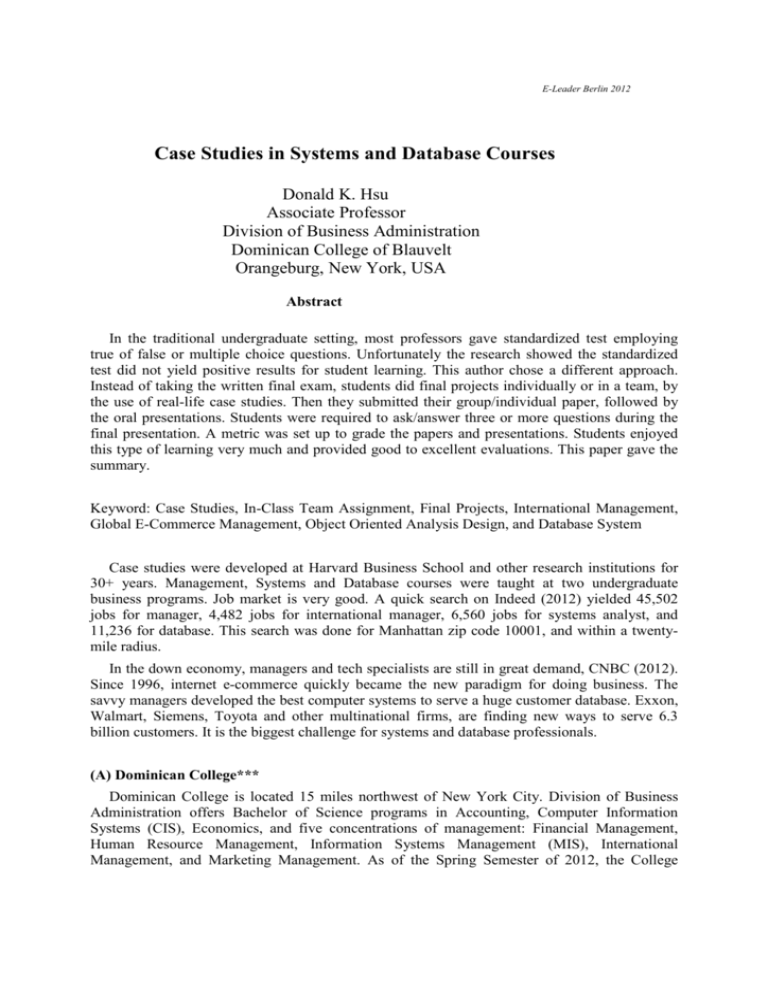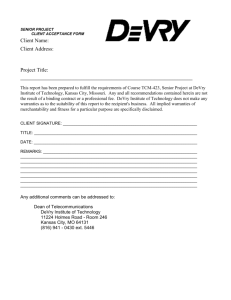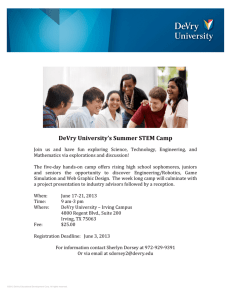
E-Leader Berlin 2012
Case Studies in Systems and Database Courses
Donald K. Hsu
Associate Professor
Division of Business Administration
Dominican College of Blauvelt
Orangeburg, New York, USA
Abstract
In the traditional undergraduate setting, most professors gave standardized test employing
true of false or multiple choice questions. Unfortunately the research showed the standardized
test did not yield positive results for student learning. This author chose a different approach.
Instead of taking the written final exam, students did final projects individually or in a team, by
the use of real-life case studies. Then they submitted their group/individual paper, followed by
the oral presentations. Students were required to ask/answer three or more questions during the
final presentation. A metric was set up to grade the papers and presentations. Students enjoyed
this type of learning very much and provided good to excellent evaluations. This paper gave the
summary.
Keyword: Case Studies, In-Class Team Assignment, Final Projects, International Management,
Global E-Commerce Management, Object Oriented Analysis Design, and Database System
Case studies were developed at Harvard Business School and other research institutions for
30+ years. Management, Systems and Database courses were taught at two undergraduate
business programs. Job market is very good. A quick search on Indeed (2012) yielded 45,502
jobs for manager, 4,482 jobs for international manager, 6,560 jobs for systems analyst, and
11,236 for database. This search was done for Manhattan zip code 10001, and within a twentymile radius.
In the down economy, managers and tech specialists are still in great demand, CNBC (2012).
Since 1996, internet e-commerce quickly became the new paradigm for doing business. The
savvy managers developed the best computer systems to serve a huge customer database. Exxon,
Walmart, Siemens, Toyota and other multinational firms, are finding new ways to serve 6.3
billion customers. It is the biggest challenge for systems and database professionals.
(A) Dominican College***
Dominican College is located 15 miles northwest of New York City. Division of Business
Administration offers Bachelor of Science programs in Accounting, Computer Information
Systems (CIS), Economics, and five concentrations of management: Financial Management,
Human Resource Management, Information Systems Management (MIS), International
Management, and Marketing Management. As of the Spring Semester of 2012, the College
E-Leader Berlin 2012
enrolled 2100+.
Hsu taught all courses in CIS/MIS, served as the Director of Business Administration
Division, from 1990 to 1996. Starting in 1992, Hsu also taught courses in International
Management curriculum: International Business, International Finance, International
Management and Global E-Commerce, Hsu (2006) and Hsu (2011).
1. MG 355 International Management course
This course aims to investigate specific issues in the governance of multinational enterprises.
Topics include: foundations for international management, managing across cultures, strategic
planning, managing political risks, organizing operations, decision making and controlling,
personnel selection and repatriation, training and organization development, labor relations,
communications, motivating human resources, and ethical social responsibility, Hsu (2011).
Jonathan and Doh (2012) wrote the textbook. During a typical class, chapters were covered
with PowerPoint presentations, and question/answer followed. Real-life examples were given
whenever applicable. Who is the richest woman CEO in the world? How does she make money?
Who is the #1 company in NY? What is the China direct investment in USA 2003-2011? Why is
the Japanese economy so bad? What is the strategy for Volkswagen to come back to the US
market?
The most important deliverable is the Final Project. Students work individually or in a group
to do research on global billionaires. They are the international managers and exceptionally
successful in managing their global businesses.
Table 1 lists the topics for the final projects in the day class. Table 2 shows the group projects
for the Accel evening class. Students submitted ten-page paper with 10+ PowerPoint slides. The
paper grade was the same for the group, but PowerPoint grade was different for the individual in
the same group. Students presented their final projects with question/answer followed. The
student evaluations were good to excellent.
2. MG 366 Global E-Commerce course
Thirteen people registered in Spring Semester 2012. This course was modified to add much
internet hardware and software content. The three CIS/MIS majors used this course as a
computer elective.
Turban (2010) wrote the textbook. Ebay and Amazon served as examples of the American
success stories for E-commerce. Much discussion focused on the business model of: Facebook,
Expedia, Freshdirect, JetBlue, Google, Groupon, Hulu, Ingdirect, Linkedin, Netflix, Orbitz,
Pandora, Priceline, Skype, Ticketmaster, Twitter, YouTube, Zappos, Zipcar, and Zynga. Chinese
E-commerce firms that traded publicly in USA are: Alibaba, Bidu, Giant Interactive, Netease,
Renren, Shanda Games, and Sina. Why are their stock prices going down since the IPO? Is
Facebook a good business model? Why is it banned in China? Why is Apple making iPod,
iPhone, and iPad in China? Why is it that Google bought Motorola? Are there successful E-
E-Leader Berlin 2012
commerce in Brazil, Russia, and Eastern Europe? Can you start a global E-commerce today and
make money? What is the reason that people will pay your product/service online? This type of
question keeps the lecture alive and students are challenged to find answers.
In addition, this course covered 7 non-US countries, taking E-commerce to the global level. In
the continental Europe, 40+ discount airlines are now operating to benefit travelers. There are 27
countries with 500 million people in the European Union. Each discount airline started with just
one E-commerce website, and tried to be the next RyanAir or EasyJet. Final projects involved
the comparison between a discount airline and a traditional airline, covering Czech Republic,
Finland, Germany, Ireland, Sweden, and UK, Table 3.
(B) DeVry University*
DeVry University (DV) is a for-profit firm that has significant impact to the University
Education community. DV has 93 locations offering online or onsite courses, throughout the
United States. It trades in the stock market under the stock symbol DV. Its stock price was
$28.89 as of 5/29/2012. DV has 93,000+ students in 26 states and Canada. DV also offered
thousands of courses online. The total population is estimated as 130,000 students, if online
students are included.
The Oracle based DV eLearning platform (eDV), is a powerful learning tool for both the
instructor and the students. DV eDV helpdesk is available 24/7 and 365 days, with toll free
telephone and online support. Registered MBA students signed in with the D numbers and
passwords. They were able to preview course syllabus, chapters, assignments and references.
Instructor’s screen contained the same materials, but instructor could modify assignments,
created the grade book, and received assignments online. Short quizzes using multiple choices
and true/false questions were graded by eDV. This feature saved much time for the instructor.
Discussion questions were posted on eDV. Students posted the threaded discussion a minimum
of three different days per week for each graded question. Midterm exam or final exam could be
done online if needed. Course Project requirement was posted on eDV. The important thing is to
cover the terminal course objectives (TCO). eDV made an elaborate effort in continuously
updating its TCO for each course.
1. CIS 339 Object Oriented Analysis and Design
This course was offered at DeVry Paramus campus with 10 students, July – August 2011.
Dennis et al (2007) wrote the textbook. This course is a continuation of CIS 321 Structured
Analysis Design. Students explore techniques, tools, and methods used in the object-oriented
approach to developing applications. Students learn how to model and design system
requirements using Unified Modeling Language (UML) tools such as use case, class, and
sequence diagrams.
Ten chapters were covered in eight weeks. Students need to post online threaded discussion, a
minimum of three different days per week. There is an online quiz and iLab work every week.
Quiz is graded by the eDV. iLab needs to be submitted every week. In CIS 321 course, the
software drawing tool used was Microsoft Visio. All students took CIS 321 course, so they are
familiar with the use of MS Visio.
E-Leader Berlin 2012
In CIS 339, IBM Rational Software Architect (RSA) was employed. To access RSA, students
would log on the Citrix Server first. Then with the right password, RSA is accessible. This seems
easy. But when students saved files, the files could not be retrieved. Some saved them in the
Citrix Server. Others saved them on their own flash drives. The issues could not be solved until
few weeks later. The video instruction in the course shell did not work. Help desk could not
provide answers for this type of questions. This curriculum needs to be upgraded.
This author installed IBM RSA on his personal Dell laptop in the first week of class. It
worked fine. Since Citrix Server caused much issue. It was recommended to all students, that
they should do the same, to install IBM RSA directly, on their home PCs or laptops. Several
students did the installation and were very happy with the results.
Final Exam is a project that involves five groups of two people each on: a) Dragon System, b)
IBM DB2, c) Microsoft Sql Server, d) Oracle 10g, and e) Rosetta Stone System. Students need to
provide one page layout for Class Responsibility Collaboration (CRC) card and two pages for
visual diagrams using IBM RSA software. Then students prepared 12-15 PowerPoint slides.
They presented their projects at the final class. The PowerPoint content is the same grade for the
group, but the oral presentation grade is different. By doing the final projects, students learn the
practical usage of IBM RSA. As a result, all ten people in this class did well.
2. CIS 336 Introduction to Database with Lab
This course was offered at DeVry Paramus campus for 5 students, October – December 2011.
The class met two nights per week, three hours per night, for a total 48 hours. Textbook was
written by Rob and Coronel (2007). This course introduced the concept and methods to database
development and us, including data analysis, modeling and Structure Query Language (SQL).
Students explored the basic functions and features of a database management system (DBMS),
with an emphasis on the relational model. Nine chapters were covered in details. Students posted
online threaded discussion, a minimum of three different days per week. There was an online
quiz and iLab every week. Quiz was graded by the eDV.
For the weekly iLab assignment, students would use the Oracle SQL Plus, available on the
Citrix Server. It worked very well. Example files were available in the Doc Sharing folder. To
modify and execute the example file, using the Oracle SQL server, was not too difficult. But the
iLab work was very tedious. This author would lecture about 1.5 hour each class. The rest of the
class time was devoted for students to work on the iLab. It was a lot of “hands-on” work for
students working alone.
After two weeks, five people were assigned as two groups, with two in one group and three in
another group. Working with others, the weak students were able to catch up. This approach was
a lot better than working alone. Final Exam was a project presentation with the requirement as
below:
•
•
Install the demo or trial version of the Server, on your home PC.
If it is successful, then do the next steps.
E-Leader Berlin 2012
•
•
•
•
•
•
If not, contact company, industry experts, instructors.
Create a table, insert data into this table.
Employ three or more SQL statements for query.
Show the results of the query.
Document the whole process, by using 8+ PowerPoint slides.
One of the slides is to use MS Visio for a process flowchart.
The projects completed were: a) IBM DB2 Server, b) Microsoft SQL Server, c) My SQL
Server, d) Oracle 10g Server, and e) Sybase Server. Some of these projects took 20 more hours
to complete.
Evaluations from students: 4 exceeded expectation, 1 met expectation. The mean is 3.80.
Comments were:
•
•
•
This course is full of information.
You learn a lot from the class.
Instructor is very helpful.
Conclusion
With the down economy, many students were interested in learning real-life international
management, global e-commerce, system and database Management. These courses were taught
at two firms to 64 people. Discussing the PowerPoint slides with real-world examples made the
lectures interesting. Asking student questions keep them engaged in the classroom. Hands-on
approach, in-class team exercises, homework assignments, role play, Harvard case studies,
online Blackboard discussion, online DeVry e-platform, use of the IBM RSA software, MS
Visio, Oracle Sql Plus, MS Sql Server, internet search, final oral presentation, gave the best
chance of success. Student assessments were good to excellent.
*** Full-time position
* Part-time consultant
Reference
CNBC 2012, http://www.cnbc.com.
Dennis, A., Wixom, B. H. and Tegarden, D., 2007, “Systems Analysis and Design with UML
Version 2.0: An Object-Oriented Approach”, 3rd Edition, ISBN#04700-74787, John Wiley &
Sons, Inc, New York, NY.
Indeed 2012, http://www.indeed.com.
Hsu, D. K., 2006, “From Project Management to Project Unlimited”, Refereed Proceeding
ISECON conference, Volume 23, $3134, 9 pages, ISSN 1542-7382, Dallas, Texas, November.
Hsu, D. K., 2011, “Case Studies in Personal Finance, Applied Electronics, International
Management and Global E-Commerce courses”, with Robert Levit, Refereed Program of E-
E-Leader Berlin 2012
Leader Vietnam, ISSN 1935-4819, Chinese American Scholars Association, http://www.gcasa.com, January.
Hsu, D. K., 2011, “Competing with Internet III, Twitter, Web 2.0 and Recruiting Women
Business IT Majors”, pps 295-300, Proceedings the 5th Intl Multi-conference Society Cybernetics
Informatics, Vol I, Winter Garden, Florida, July.
Luthans, F. and Doh, J. P., 2012, “International Management”, 8th edition, ISBN#00781-12575,
McGraw-Hill, New York, NY.
Rob, P. and Coronel, C., 2007, “Database Systems: Design Implementation and Management”, 7th
Edition, Course Technology, Cambridge, MA.
Turban, E., 2010, “Electronic Commerce”, ISBN# 01361-00414, Pearson Prentice Hall, Upper Saddle River,
NJ.
Acknowledgment
Thanks are given to Dr. C. Pennino and Business faculty at Dominican College for support.
The faculty research grants and two sabbatical awards from Dominican College are appreciated.
The author thanked Mr. Thomas Kist of DeVry North Brunswick and Mr. Pavi Jalloh of DeVry
Paramus, for the opportunity to teach their students. It has been a very gratifying experience.
MG 355
International
Table 1 Management
Group A
Anderson
Tuzzolino
Group C
Diaz
Reyna
Group E
Avila
Jean-
Topic
Georgina Rinehart
Hancock Prospect
Australia
Topic
Eike Batistia
EBX Group, Brazil
Topic
Amancio Ortega
Zara, Spain
Final Group
Project chart
Group B
Topic
Filip
Bernard Arnault
Waters
LVMH, France
Group D
Topic
Accardi
Rodier
Michele Ferrero
Ferrero Rocher, Italy
Group F
Topic
Moore
Sadowske
Prince Alwaleed
Kingdom
E-Leader Berlin 2012
Bap
Group G
Ginyard
Johnson
Group I
LaPorte
Table 2
Name
McNarmara
Clark
Colley
Rivera
Rai
Rosarian
Docu
Holohan
Brown
Davis
Saudi Arabia
Topic
Li Ka-Shing
Hutchison, Hong Kong
Topic
Stefan Persson
H & M, Sweden
MG 355-L
International
Management
Topic
Group A
Eike Batista
EBX, Brazil
Group B
Amancio Ortega
Zara, Spain
Group C
Lakshmi Mittal
Mittal Steel,
Luxembourg
Group D
Bernard Arnault
LVMH, France
Group E
Stefan Persson
H & M, Sweden
Group H
Topic
Evans
Santana
Carlos Slim Helu
Telmex, Mexico
Group J
Topic
Smith
Whiteley
Alisher Usmanov
Metalloinvest, Russia
Final
Project Chart
Name
Topic
Group F
Shubert
Rodrique
Michele Ferrero
Ferrero, Italy
Group G
Li Ka Shing
Cheung Hong
Group H
Carlos Slim Helu
O’Shea
Ferguson
Evdo
Chavez
Petrossi
Telmex, Mexico
Group I
Prince Alwaleed
Kingdom, Saudi
Arabia
E-Leader Berlin 2012
MG 366
Final Projects
European
Airlines
Case Study
Names
Country
Project
1
Bermudez
Patino
Germany
Lufthansa
Air Berlin
2
Balkaran
McFarlane
Ireland
AerLingus
Ryanair
3
Roldan
Ventura
Sweden
ScandJet
SAS
4
Moulton
Steigert
Czech
Republic
Czech Airline
Smart Wings
5
Medina
Navarro
Finland
FinnAir
Blue 1
6
Castillo
Marcano
Young
UK
British Airway
BMI Baby
EasyJet
Table 3








